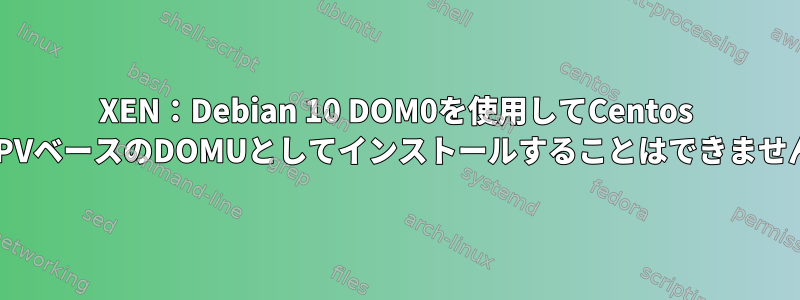
私の目標は、Debian 10を介して管理/インストールされたXenシステムにCentOS 8をゲスト/DOMUとしてインストールすることです。
ハードウェアが古すぎてHVMをサポートしていないため、PVを使用する必要があります。 HVMは明らかにこのプロセスを大幅に簡素化します。
Debian PVを作成するのは簡単ですが、ISOやリポジトリから外部オペレーティングシステムをインストールすることは私のようなXen初心者にとっては難しいことが証明されています。
私をここに導いた2つの資料は次のとおりです。
https://wiki.alpinelinux.org/wiki/Create_Alpine_Linux_PV_DomU
https://www.systutorials.com/install-paravirtualized-centos-7-domu-xen/
次の構成を使用して仮想マシン(centos-8.2.pvlinux)を作成します。カーネルとRAMディスクがコメントアウトされており、CentOS PXEBootカーネルとRAMDiskをダウンロードまたは抽出すると、プロセスの最初にエラーが発生し、「/」にDebianバージョンを使用することが少なくとも最初は機能しているようです(CentOSで)。イメージダウンロードバージョン)/centos/8.2.2004/BaseOS/x86_64/os/images/pxeboot/')。
kernel = "/vmlinuz"
ramdisk = "/var/opt/xen/ISO_Store/CentosPXEBoot/initrd.img"
#ramdisk = "/initrd.img"
extra="modules=loop,squashfs console=hvc0"
# Path to HDD and iso file
disk = [
#'file:/vmdisk0,xvda,w'
'format=raw, vdev=xvda, access=w, target=/dev/mapper/vg_1-domain.com',
'format=raw, vdev=xvdc, access=r, devtype=cdrom, target=/var/opt/xen/ISO_Store/CentOS-8.2.2004-x86_64-boot.iso'
]
#extra="ksdevice= inst.repo=https://mirror.jaleco.com/centos/8.2.2004/isos/x86_64/ nameserver=1.1.1.1"
# Network configuration
vif = ['bridge=xenbr0']
# DomU settings
memory = 3072
name = "centos-8.2"
結果は次のとおりです。出力を短縮しました。
Parsing config from /etc/xen/centos-8.2.pvlinux
[ 0.000000] Linux version 4.19.0-10-amd64 ([email protected]) (gcc version 8.3.0 (Debian 8.3.0-6)) #1 SMP Debian 4.19.132-1 (2020-07-24)
[ 0.000000] Command line: modules=loop,squashfs console=hvc0
....
[ 16.434798] systemd[1]: Detected virtualization xen.
[ 16.434844] systemd[1]: Detected architecture x86-64.
[ 16.434880] systemd[1]: Running in initial RAM disk.
Welcome to CentOS Linux 8 (Core) dracut-049-70.git20200228.el8 (Initramfs)!
[ 16.446415] systemd[1]: No hostname configured.
[ 16.446473] systemd[1]: Set hostname to <localhost>.
[ 16.446725] random: systemd: uninitialized urandom read (16 bytes read)
[ 16.446775] systemd[1]: Initializing machine ID from random generator.
[ 16.621449] random: ln: uninitialized urandom read (6 bytes read)
[ 16.623730] random: ln: uninitialized urandom read (6 bytes read)
[ 17.062380] systemd[1]: Reached target Timers.
[ OK ] Reached target Timers.
....
[ OK ] Started iSCSI UserSpace I/O driver.
[ OK ] Stopped iSCSI UserSpace I/O driver.
[FAILED] Failed to start iSCSI UserSpace I/O driver.
See 'systemctl status iscsiuio.service' for details.
[ 22.462372] systemd[1]: Started Journal Service.
[ OK ] Started Journal Service.
[ 23.688098] dracut: FATAL: iscsiroot requested but kernel/initrd does not support iscsi
[ 23.688178] dracut: Refusing to continue
[ 23.869896] systemd-shutdow: 56 output lines suppressed due to ratelimiting
[ 24.013409] systemd-shutdown[1]: Syncing filesystems and block devices.
[ 24.013708] systemd-shutdown[1]: Sending SIGTERM to remaining processes...
[ 24.019611] systemd-journald[121]: Received SIGTERM from PID 1 (systemd-shutdow).
[ 24.026531] systemd-shutdown[1]: Sending SIGKILL to remaining processes...
[ 24.032149] systemd-shutdown[1]: Unmounting file systems.
[ 24.038715] [371]: Remounting '/' read-only in with options 'size=1497604k,nr_inodes=374401'.
[ 24.039938] systemd-shutdown[1]: All filesystems unmounted.
[ 24.039986] systemd-shutdown[1]: Deactivating swaps.
[ 24.040223] systemd-shutdown[1]: All swaps deactivated.
[ 24.040259] systemd-shutdown[1]: Detaching loop devices.
[ 24.040650] systemd-shutdown[1]: All loop devices detached.
[ 24.040687] systemd-shutdown[1]: Detaching DM devices.
[ 24.051030] xenbus: xenbus_dev_shutdown: device/vif/0: Initialising != Connected, skipping
[ 24.051080] xenbus: xenbus_dev_shutdown: device/vbd/51744: Initialising != Connected, skipping
[ 24.051114] xenbus: xenbus_dev_shutdown: device/vbd/51712: Initialising != Connected, skipping
[ 24.051183] reboot: System halted
ISOを削除し、Extrasラインを使用してISOを取得しようとしましたが、同じ結果が得られました。
また、同じ結果としてボリュームグループではなくディスクを作成してみました。
どんな案内でも大変感謝いたします。ありがとうございます。
修正する:
簡単に言えば長い話です。 CentOS 8がPV環境をサポートしていないことには共感があるようです。
この機能は、デフォルトのHVM設定よりもはるかに優れたパフォーマンスを発揮するPVH環境の使用を妨げるため、サポートされていない理由を理解できません。
elrepoのサードパーティカーネルを使用するためのPV内サポートが明らかにあります。しかし、それを使ってPVにCentos8をインストールする方法を知りたくありません。このカーネルは、HVM で PV インターフェースを使用する PVH 環境を使用したい個人に主に役立つようです。
今、別のオペレーティングシステムを使用する必要があります。
答え1
CentOS 8のデフォルトカーネルはXen PVまたはPVHをサポートしません。これはRed Hatによって削除されました。 HVMで実行できますが、ハードウェアはそれをサポートしていないと言います。
CentOS 8はelrepoを有効にし、kernel-mlをカーネルとして使用してPVまたはPVHモードで実行できます。これはメインラインのLinuxカーネルなので、Xen PV / PVHサポートは削除されませんでした。しかし、elrepoはいかなる種類のサポートも提供しません。
既存のLinuxまたはUnix系コンピュータからchrootにインストールできます。以下は、このプロバイダの「Rescue VM」を使用するためのいくつかのステップバイステップのガイドラインです。ホストへの管理アクセス権がある場合は、そこから続行できます。


